The killings, which are said to have occurred on February 22, came during a botched attempt by the military to transfer about 20 would-be refugees from the large boat on which they arrived from Burma (Myanmar) with 110 others, to a much smaller vessel.
When some feared they would be separated from family members, they jumped in the water and the military men opened fire during the predawn incident, the witnesses said.
Survivors Habumara, 20, Rerfik, 25, and Jamar, 16, said yesterday that they swam for their lives when the shooting broke out. They are currently being sheltered by sympathetic villagers.
Two fresh graves, said to contain Rohingya, were seen by a Phuketwan reporter and an Australian news television crew yesterday.
The three survivors said they believed that the killers were members of the Thai Navy, but village residents said they probably belonged to another branch of the Thai military.
Previous abuses of the Muslim Rohingya have been carried out by other arms of the Thai military or operatives trained as paramilitaries.
Vice Admiral Tharathorn Khajitsuwan, the Commander of Thai Navy Three, which patrols the Andaman coast, declined to comment.
One Rohingya, Rerfik, said that their boat, which had run out of fuel on its journey from Burma, was intercepted by local Thai fishermen on February 21.
The fishermen helped them ashore at a beach on Surin island, a popular destination for international tourists on dive boat and snorkelling excursions.
''Other local people brought us food and water,'' Rerfik said. A meal was provided on the beach for the exhausted boatpeople.
At 6.30pm that day, a military boat arrived at the beach. A video shot by villagers shows the Rohingya craft being towed close to shore by a vessel with the hull designation TOR214, which is listed as a Thai Navy fast patrol boat.
''The villagers told us not to worry, we were told that they were just going to transfer us safely to the mainland,'' Rerfik said.
But the next morning, the military decided to transfer 20 of the Rohingya to the smaller vessel nearby offshore, and the shooting broke out.
''There was a shot fired into the air when we decided not to move,'' Refrik said. ''And so we jumped. That's when they opened fire on us, in the water.''
''We all heard the gunshots,'' a fisherman told a local woman who had been waiting by the pier for the Rohingya boat to be brought to shore.
''A little bit later, Rerfik was pulled from the water. During the day, the others were found and rescued.''
Two bodies were also pulled from the water and buried, with fishermen telling villagers they had seen more bodies in the water. As many as 15 people may have died, the fishermen told the villagers.
The residents of the village north of Phuket are now sheltering four survivors, as well as another Rohingya who arrived on an earlier boat.
Soldiers descended on the village and searched the area for two days after the incident, but the survivors were kept hidden.
The fate of the other 100-plus Rohingya is not known, after they were towed away by the military vessel.
The Thai military has previously been accused of cooperating with people traffickers by handing over boatpeople who are then smuggled to Malaysia for a large fee or sold as bonded laborers.
Habumara said: ''Most of us were hoping to reach Malaysia but my aim is to go on from there to Australia. We are not sure what will happen to us now.''
Thailand has been swamped this October-April ''sailing season'' by Rohingya, who are fleeing persecution and deprivation in their native Burma and border areas in Bangladesh.
Thousands have set sail to escape a recent outbreak of violence targeting their communities.
In 2009, the Thai military was revealed to have secretly adopted a policy of towing Rohingya out to sea in powerless boats and casting them adrift. Hundreds died as a result. The policy was quickly abandoned by then prime minister Abhisit Vejjajiva.
Since 2009, the Thai military has adopted a ''help on'' policy. Rohingya boats are intercepted at sea and supplied with food, water and fuel, on condition that they do not come ashore in Thailand.
Persecution of the Rohingya in Burma has grown with renewed violence since June, forcing thousands of people to flee by sea - and including women and children for the first time this October-to-April ''sailing season.''
As a result, Thailand has been swamped with record numbers of Rohingya. The arrival of women and children in boats - first reported by Phuketwan on January 1 this year - led to Rohingya being brought ashore through January and raids on secret Thai-Malaysia people-traffickers' camps, where more women and children were discovered.
Detention centres and refuges throughout Thailand are now crowded with 1700 Rohingya whose status and fate is being decided by the Thai government, with advice coming from NGOs, between now and July.
A military vessel connects with a Rohingya boat
Would-be refugees on a beach at Surin island
A version of this article appears in Thursday's edition of the South China Morning Post newspaper in Hong Kong.

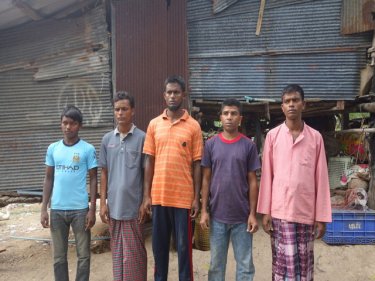






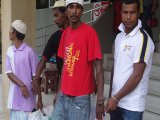
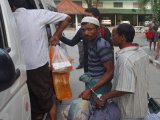



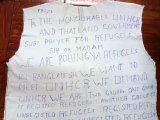
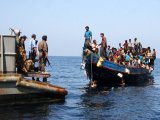

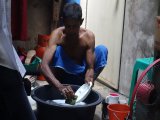
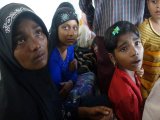

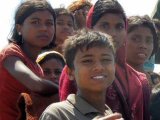
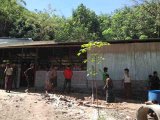

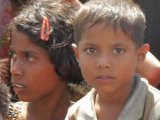

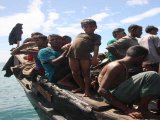
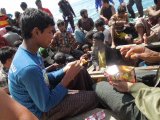
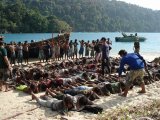
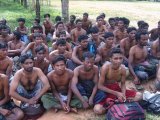
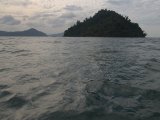



Inexcuseable...
Posted by J on March 6, 2013 20:52